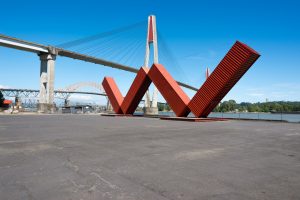
The art of today can be the tourism of tomorrow
By Katie Czenczek, News Editor
Whether or not you like public art, it goes without saying that in some way it has impacted your life.
On November 21 from 6:30 to 8:30 pm, Douglas College hosted an Urban Challenges Forum. Held in Room 2201, the theme for this debate was whether public art should be government funded or not, and what the implications of public art are if it is paid for by governing bodies.
The event was moderated by Darcy Cutler, a faculty member in the Department of Philosophy and Humanities at Douglas College. He gave the opening welcome and territorial acknowledgment.
Following Cutler was another Douglas College faculty member, Dr. Julian Brooks. Brooks opened up the conversation by presenting famous statues found throughout the world and giving them greater context. Brooks focused on public art that arose out of the Socialist movement in Eastern Europe during the Second World War. Some countries—Serbia was used an example—choose to commemorate those statues to this day, while other like Hungary took them down, he said.
“In Hungary, there was this move to get rid of all of the Communist statues. Really the difference here is that in Hungary, they had socialism imposed upon them after the Red Army defeated the Germans in 1945.”
Brooks also went on to discuss how tourists flock to these monuments. He moved southwards in his presentation by then focusing on two different cities—Athens, Greece and Skopje, Macedonia.
“Athens, we have the Agora, the Stoa, Classical statues, striking columns; this is beauty, authenticity, symmetry, good taste,” he said. “The very genesis of Western civilization. When we compare it to Skopje, not so much.”
He gave a brief history about Skopje’s transformation in 2014, when the nationalistic government led by Nikola Gruevski funded Classical-inspired statues to be built all over the Macedonian city. The most famous of these statues is one of Alexander the Great in the middle of a major courtyard.
“There were those who supported the project,” he said. “The government argued that the project was a much-needed revamp of the dreary socialist architecture, would give people something to be proud of in their city, and attract tourism.”
The fallout of the project was that it cost 650 million euros to create all of the statues, for which the government only originally budgeted 80 million at the start of the project.
“That’s a lot for one of Europe’s smallest countries with the population of the Lower Mainland,” Brooks said.
After Brooks finished his presentation, City Counsellor for New Westminster Mary Trentadue spoke about the benefits of public art. She said that public art is easily accessible to everyone.
“The things that’re important about public art to me is that it’s free,” she said. “It’s available to all people, regardless of their age, demographic, culture, and socio-economic status. Public art reflects who we are as a society through the lens of an artist.”
She also highlighted some of the public art initiatives that the New Westminster government has implemented, such as the WOW Westminster art installation in Westminster Pier Park. Trentadue went on to talk about the controversy about that art installation and how people have given her mixed results on the installation.
“Not everyone believes that we should be spending public money on public art,” she said. “I’m not convinced that we will ever be able to convince those who are against public art that it’s a good idea for any community.”
Following both Brooks and Trentadue’s talks, audience members were invited to ask either speaker questions about art before the event wrapped up.
The next Urban Challenges Forum will focus on the topic of environmental justice on January 23 of next year.


